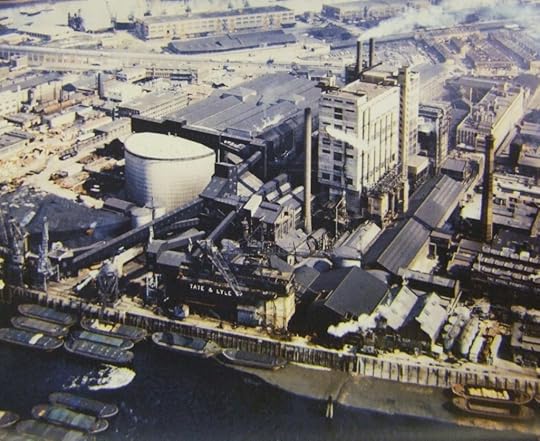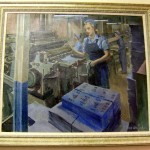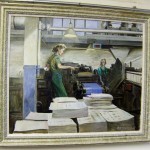Duncan Barrett's Blog, page 5
March 17, 2012
Fifties beauty queens from Tate & Lyle
This vintage pamphlet from 1953 shows the beauty queen hopefuls who entered a competition to become that year's Miss Tate & Lyle.
The company's beauty contest, unsurprisingly now consigned to the dustbin of history, was once a highlight of the annual Sports Day, when hundreds of Tate & Lyle workers and their families thronged the sports ground at Manor Way.
Girls competed first to be the beauty queen of their respective refinery – as Miss Plaistow Wharf or Miss Thames – and then for the overall title of Miss Tate & Lyle.
There was much rivalry between the office girls and the factory floor workers – a reflection of the social divide that existed between the two, with the factory girls determined not to let the office workers get 'one up' on them.
Movie stars of the era, such as Derrick De Marney, Dennis Price and Paul Dupuis, would judge the contest, and got the privilege of kissing the winner.
Miss Tate & Lyle herself would receive the coveted beauty queen sash and tiara, and appear on the cover of the following month's Tate & Lyle Times.
As the pamphlet mentions, the contest was even the subject of a sweepstake, with a holiday on offer as the prize.
Many thanks to former Tate & Lyle engineer John Bentley, who sent us a picture of it, having treasured it for almost 60 years.
John Bentley
Today we spoke to a man called John Bentley, who worked at Tate & Lyle's Thames Refinery in Silvertown for forty years, starting in August 1953 at the age of 16.
When he began working for Tate & Lyle, John was an apprentice electrical engineer. He lived in Stratford and would travel to the factory on his bike every morning. He loved the job, and felt the company really looked after its workers, but as far as John was concerned, the best thing of all about working at Tate & Lyle was the sugar girls. With so many young female colleagues, he described it as 'like being in a sweet shop'!
John would dash down to the canteen at the start of his lunch break, hoping to catch the girls before they went back to work so that he could chat them up. His first girlfriend at the factory was called Christine and worked on the Hesser Floor, but over the years John went out with many other sugar girls. He would visit them at their machines throughout the day, taking care to make himself scarce if one of the foreladies put in an appearance. (The boys at the factory weren't officially under their control, but they were formidable women and didn't like their girls being disturbed on the job.)
As well as girlfriends, John formed strong male friendships at Tate & Lyle, and he is still in touch with many of his fellow engineers today, sixty years since they began working together at the factory.
Over the course of his four decades at Tate & Lyle, John saw many changes at the factory. As automation became more widespread and machines took over much of the work of packing, the number of female workers sadly dwindled. But John still remembers the good old days of the early 1950s when the canteen would be packed every lunchtime with up to 500 people, among them plenty of sugar girls waiting for a nice young man to come up and talk to them.
The Sugar Girls blog tour
Over the past few weeks, as well as keeping up the official Sugar Girls blog here, we have been writing guest posts for a number of other blogs. Here are some little tasters of the four that have gone online so far, along with links to the blogs they appear on, where you can learn about many different aspects of The Sugar Girls.
Over at the excellent Writing Women's History blog, you can read an overview of what it was like to be a Sugar Girl, and why every young school leaver in the area hoped to get a job at Tate & Lyle.
"It's officially the oldest brand in Britain, but few people know the full history of Lyle's Golden Syrup, and of the young East End girls whose hard work went into every tin. In the mid-20th century, thousands of girls left school each year aged 14 or 15 and headed straight to the company's factories in Silvertown. There were several departments staffed almost exclusively by women – the can-making and syrup filling, where the iconic tins were crafted and filled, the Blue Room, where the sugar bags were printed, and the Hesser Floor, where the bags were filled with sugar and packed up onto pallets…"
At History Workshop Online, we wrote about the kinds of stories the women we spoke to told us about working at the factories, and what it was like basing our book on their interviews.
"They told us of the hard work at the factory, where they made their own paper thimbles to prevent their fingers from bleeding. One woman described being sent down to the on-site surgery to have her wrists bound up, so painful were they after a day stacking huge piles of sugar bags. A doctor and nurse were on hand at all times to deal with all manor of complaints – from period pains (peppermint tea and an hour off work was the usual prescription), to the inevitable cuts and grazes from the machinery. In the event of more serious accidents, a Tate & Lyle ambulance would rush workers to hospital – and we heard many stories of hands being caught in the machines, of fingers being lopped off, and even the odd workplace fatality: one man was said to have drowned in a sugar silo, and another to have burnt to death in the charhouse…"
Throughout March, the Women's History Network are publishing an article every day in celebration of Women's History Month. Today they are featuring our blog about Edna Henry, a black sugar-packer who took on her male managers, and won!
"Edna was one of the first black women to work at the factory, and from her earliest days at Tate & Lyle she learned that she would need to fight in order to be treated fairly. When a promotion went to the sister-in-law of a supervisor, even though Edna had longer service and better time-keeping than the other girl, she bravely knocked on the door of the forelady's office and demanded that the managers reconsider their decision. After checking her service record, they were forced to acknowledge that the job should have been hers, and reluctantly gave her the promotion…"
Amazing Women in History is a wonderful blog dedicated to 'all the kick-ass women the history books left out', so we were delighted when they agreed to publish a blog about the formidable Labour Manageress at Tate & Lyle, Miss Florence Smith.
"As the top woman at Tate & Lyle's Plaistow Wharf refinery in Silvertown, Miss Smith was in charge of hiring and firing the 1,500-strong female workforce, among whom she had acquired a legendary reputation. Young girls looked up to her with a combination of terror and awe, and whenever she was spotted approaching on her daily rounds, a whisper of 'The Dragon's coming!' would quickly spread across the factory floor…"
We hope to be doing more guest blogging in the coming weeks, so check back for information on other great blogs where you can find out about The Sugar Girls.
March 15, 2012
Searching for memories of Violet McCollough
This morning we received a message from a man called Andrew, who is hoping to track down anyone who might remember his Great Aunt Violet McCollough, or who might have pictures of her. Violet worked at Tate & Lyle's Plaistow Wharf refinery from the age of fourteen, early in the twentieth century, and remained there for many years. According to Andrew, when she started at the factory she had to stand on a box on account of her diminutive height, but she ended up as a supervisor over the girls. She was well suited to working in a sugar factory as she had a sweet tooth herself – as well as enjoying a good knees up and a glass of Southern Comfort!
Violet was not the only McCollogh to take a job at the factory. Her father Robert was a steeplejack and worked on the Plaistow Wharf chimney – according to family legend, it was he who laid the final brick in it. Her brother Bob also worked for Tate & Lyle, and features in a book about the company, where he can be seen cleaning up after work in a bathtub.
Do you have any memories of Violet, Robert or Bob? If so, please post a comment below, or get in touch via our Contact page and we will pass the information on to Andrew.
March 11, 2012
Happy Birthday, Henry Tate!
Today marks what would have been the 193rd birthday of Henry Tate, the Liverpool grocer turned sugar magnate, whose company Henry Tate & Sons merged with that of Abram Lyle to form Tate & Lyle.
Henry and Abram's East End factories were only a mile apart, yet they never met during their lifetimes. The two men were bitter business rivals, but in 1921, long after they had both died, their respective boards decided that joining forces was the obvious way forward. Today, their portraits hang at opposite ends of the Tate & Lyle archive in Silvertown – here is Henry, looking down benevolently on his company.
Henry Tate was the seventh son of a Unitarian clergyman. He first got into sugar in 1859, with a Liverpool refiner by the name of John Wright, before setting up his own refinery in Love Lane in 1870. With business booming on the Mersey, he was keen to expand into London, and sent a man by the name of James Blake to scope out the marshy land of Silvertown. Within a year of drawing up plans for a sugar refinery on the north bank of the Thames, it was open, and refining began in earnest in 1878.
Queues formed outside the factory, as workers from the local area flocked there in search of jobs. Migrant workers travelling from Europe to America would arrive in England bearing signs marked 'TATE', and with the help of no other English words would be directed from Harwich to the gates of the refinery, where they could earn enough money for the next leg of their journey.
Some of Henry's workers travelled down with him from Liverpool to London, including a large group of Orangemen, who found themselves in trouble on the first ever company outing, to Rye House in Essex. Enjoying themselves at a fairground, they got into a fracas with a group of Irish Catholics, and before long many of them were under arrest. With his workforce locked up overnight, Henry was forced to close the factory the next day. Nonetheless, his commitment to helping his workers enjoy a good time remained, and he established the Tate Institute, a bar and dance hall opposite the Thames Refinery that soon became the top nightspot in the neighbourhood.
These days, the Tate name is remembered not just for the sugar empire that Henry helped found, but for the numerous libraries and art galleries built with his generous philanthropic donations. A great collector of art, in 1896 he offered £150,000 (a huge sum of money at the time) to help establish a National Gallery of British Art– it would not take his name until after his death – bequeathing paintings such as Millais' Ophelia and Waterhouse's Lady of Shalott to the collection.
Henry twice turned down the offer of a Baronetcy, only accepting it on the third request, in 1898, when he was told that the Royal Family would be personally offended if he refused. He died a year later, and was buried in West Norwood Cemetery, not far from his home in Park Hill, Streatham.
March 10, 2012
A visit to the Tate & Lyle archive
This week, we were given a rare peek inside the Tate & Lyle company archive, thanks to Community Affairs Manager Ken Wilson.
The archive is located in a musty room at the Thames refinery in Silvertown. On the walls hang old oil paintings of grandees from the company's two founding families, such as this portrait of Abram Lyle, the original Lyle who built the Plaistow Wharf refinery in 1881.
Here's a picture from the archive of Plaistow Wharf as it was when Abram purchased it – the land that comprised the home of the original refinery consisted of two wharves, Odam's and Plaistow, each with a strip of land that ran back to the Silvertown tramway and the North Woolwich Road.
Abram died in 1891, the same year his grandson Oliver was born. Oliver went on to join the factory when he was 21 and spent time doing various manual jobs such as working on the refinery pans, before he and his brother Philip became joint refinery directors. Philip died in 1955, by which time Oliver, pictured here, was the sole male survivor of the third generation of sugar Lyles.
Oliver Lyle was a meticulous record-keeper, as can be seen in his pocketbook, which he carried around with him for over 30 years.
The notebook is one of numerous fascinating objects arranged in cabinets that were put together for a visit by the Queen to the archive in 2008.
In this cabinet, on the right, is an example of plain wrapped slab sugar, made for prisoner of war parcels in the 1940s. On the left are cube sugars and post-rationing domestic sugars, and in the far left corner a photograph of a bear from the Russian State Circus enjoying special sugar cubes made for bears.
This cabinet, meanwhile, holds examples of the old-fashioned sugarloaf – the traditional form in which sugar was made, before the introduction of granulated and cube sugars – and of the iron sugar nips that were necessary to break pieces off from the loaf.
Behind the sugar loaves in this picture, you can see a collection of Lyle's Golden Syrup tins, the design of which hasn't changed since 1885 – making it Britain's oldest brand, according to the Guinness Book of Records. Below them are some modern-style Tate & Lyle sugar bags, and in the top left are their counterparts from the 1940s and 1950s – as printed and packed by the Sugar Girls we interviewed for our book.
Here's a beautiful old parcel of sugar, trussed up and ready for delivery – listing all the various types of sugar made by Henry Tate & Sons before the 1921 merger with Lyles.
The different delivery vans used down the years can be seen in a collection of models kept in glass cases, showing how the design for the vehicles changed with the times.
Here's an alternative means of transport, an early locomotive train – made out of Lyle's Golden Syrup tins by a Radley schoolboy! At the factory, syrup tins were often put to odd uses, whether as cups in the canteen or as figurines of long-serving workers to mark their retirement.
There's also a model of the company's former mascot, Mr Cube – introduced in 1949 for a major campaign against the Labour government's plans to nationalise sugar. Mr Cube appeared on sugar packets along with slogans such as 'Tate Not State', and there were cartoons of him in the national press. He proved so popular with the public that he was kept on as company mascot, even once the threat of nationalisation had receded.
Upstairs, on the gallery level, sit box after box of company wage records and other documents, as well as several ancient train timetable booklets, some of them listing trains between London and Edinburgh, that must have belonged to Abram Lyle. In amongst them are many old reels of film, which can't have been near a projector for decades – it would be fascinating to find out what is on them.
There's also a collection of copies of the old company magazine, the Tate & Lyle Times, which was produced monthly from 1949 onwards and was packed with pictures, gossip, wedding news, sports results, beauty contest winners, profiles of members of staff and a women's page, 'Sugar & Spice'.
Apparently, a back room holds more than 15,000 photographs which are yet to be catalogued. A few of them are included in cabinets and on boards that were put together for the Queen's visit – such as this wonderful picture of the first women working in the Thames fitting shop in 1917.
And this picture shows the women who washed and repaired the jute bags in the bag store in the 1880s.
Here's a later picture showing women workers packing on the Hesser Floor in the 1940s.
The Tate & Lyle archive is a wonderful treasure trove of photographs and artefacts and it seems a shame that this great collection is only available to view by private appointment, rather than held in a public museum. We're hoping to bring a small selection of these beautiful pictures and objects to an exhibition at The Hub, 123 Star Lane, Canning Town, from March 28th, to coincide with the launch of The Sugar Girls.
Come to our event from 11am-1pm on the 28th to see the exhibition, find out more about the history of Tate & Lyle from Ken Wilson and have tea and cake with former Sugar Girls.
March 8, 2012
Memories of a Sugar Boy
Today we spent a fascinating afternoon with Henry Southgate, aged 82, who drove Tate & Lyle's delivery vans in the late 1940s.
He showed us this devastating picture, dated 28th September, 1945, of the site where his childhood home once stood in Canning Town.
This wasteland was formerly Vincent Street, and Henry grew up there at number 56 – right where you can see the lamppost still standing.
The street was bombed in the Blitz in 1940, and then demolished entirely in 1945. Luckily Henry, who was ten when the bombs dropped, had been evacuated to Somerset.
His was one of the most badly bombed areas of London, and it was to become the site of the grand postwar house-building project the Keir Hardie Estate.
Its planners set out to build a new kind of housing for East Enders who had lost their homes in the Second World War, inspired by the ideal of the 'Garden Suburb'.
But for Henry and his young friends, returning to a Blitz-ravaged Canning Town was like coming back to an adventure playground, full of fascinating new landscapes to explore and treasures to discover – such as this piece of shrapnel he still has from his boyhood.
In fact Henry has a whole bag full of the stuff that he collected as a child, and he was kind enough to give us a couple of pieces of bonafide Blitz shrapnel to take home as souvenirs.
Henry went on to marry another Tate & Lyle worker – a sugar girl working on the Hesser Floor called Betty Holder. Here's a picture of Betty with her fellow sugar girls Sylvie Kent and Violet Holder, her sister, at West Ham Park in 1954 – proudly displaying one of the sugar bags they packed at work.
Henry and Betty met because she was friends with his sister, and one day he caught the two of them round his house sharing a cigarette. "He told us to put the fag out," recalls Betty, "and I nearly swallowed it! We've been married 56 years now."
Do you have memories of Canning Town and the surrounding area in the 1940s and 1950s? Or did you or your family work at Tate & Lyle? If so, we'd love to hear from you! Get in touch via the 'Contact' page.
March 7, 2012
Kind words from the brilliant Stan Dyson
This morning, we were delighted to see the following post on the Newham Story forum from Stan Dyson, an expert on the history of Silvertown who helped us out with our research for The Sugar Girls.
A Brilliant Book! Both Joan and I, having worked at T&L, had a bit of input and received a draft manuscript prior to publication. It's the only book that Joan read from cover to cover in just three nights. For three nights in bed I had to moan 'For Gods sake turn the side light off!' She thoroughly enjoyed it and so did I afterwards. Gritty real life stories and chances are you will know some of the characters! We were delighted to have received a paperback copy direct from Harper Collins today and Joan said she's now going to read it all again because with the draft manuscript she kept on getting the pages mixed up. Turn that bloody light off!!! Happy reading! – Stan
Stan and his wife Joan both worked for Tate & Lyle, and some of her stories feature in the book – for example the time she got her revenge on a manager who had groped her sister in the corridor. They are a lovely couple and, despite having since moved out to Essex, told us that they would go back to the Silvertown of the 1950s and 1960s in an instant if they had the chance.
A few years ago Stan published a memoir of growing up in Silvertown, Silvertown Life . It's a fascinating read and well worth checking out, as is his gallery of old photographs on the Docklands Memories website.
. It's a fascinating read and well worth checking out, as is his gallery of old photographs on the Docklands Memories website.
    <img src="http://wms.assoc-amazon.co.uk/2007082...″ alt="" /><br />
March 4, 2012
Tate & Lyle as seen from the air…

Tate & Lyle's Plaistow Wharf Refinery, as seen from the air (1960)
Here is a picture of Tate & Lyle's Plaistow Wharf Refinery in West Silvertown, as seen from the air in 1960. It gives you an impression of how busy the factory was, and how imposing the tall buildings, silos and chimneys would be for the men and women working there.
The women's departments – the Hesser Floor, can-making, syrup-filling and bag-printing – were for the most part towards the far end of the site, from the point of view of this photograph, nearer to the main entrance to the factory on North Woolwich road, which runs from left to right across the top of the picture. (The Blue Room, where the sugar bags were printed, was in the rectangular white building you can see in the top-right-hand corner of the photo.)
In the foreground, you can see the barges that would bring sugar in from boats moored in the Thames. The sugar would then be refined in the factory, before being packaged up for sale.
Thousands of men and women worked on the site in the 1950s and 1960s, and Tate & Lyle was one of the major employers in Silvertown, dominating the strip of factories lining the Thames that was known as the 'sugar mile'. (There were two Tate & Lyle factories there – the Lyle family's Plaistow Wharf Refinery and the Tate family's Thames Refinery – as well as Keiller's jam and marmalade factory, hence the name.)
March 1, 2012
The women of Tate & Lyle – in oils!



Check out these amazing oil paintings of female workers at Tate & Lyle's factories in the East End, which hang in the company archive at the Thames Refinery. You can click each image for a larger version (click twice for full-size).















